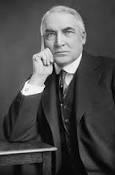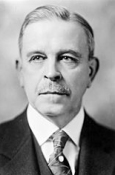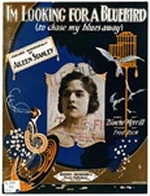
Postage Stamps of the United States - 1922
Politics

President
Warren G. Harding

Postmaster General
Hubert Work
Music

Click Control Above To Hear
1922 "I'm Looking For a Bluebird"
Postage Rates
Domestic Letter Rate: 2¢ per oz.
Postcard Rate: 1¢
Air Mail Rate: 6¢ per oz.
Stamps
The Regular Stamps First Issued in 1922 - The Fourth Bureaus - Series of 1922
Flat Plate - Perf 11 - 400 Subject Plates - see also: 1922 Series Identifier

11¢ Hayes
First Day: October 4, 1922

5¢ Roosevelt
First Day: October 27, 1922

15¢ Liberty
First Day: Nov. 11, 1922

25¢ Niagara Falls
First Day: Nov. 11, 1922

50¢ Amphitheater
First Day: Nov. 11, 1922

6¢ Garfield
First Day: Nov. 20, 1922
The 11¢ Hayes
The 11¢ Hayes stamp more than likely found its roots in the politics of the time. The current president, Warren Harding, being from Ohio, was easily persuaded to issue a stamp honoring a fellow Ohioan, commemorating the 100th anniversary of the birth of Hayes. This would be the first in the new series of regular issues, what are now known as the "Fourth Bureau Issues", or simply, the "Series of 1922".
The eleven cent stamp did not fill any particular need at the time, there already was a plentiful stock of the 11¢ Franklin (Number 511), primarily used to pay postage and insurance on parcels. In fact, the 11¢ Franklins were still being printed well into 1924.
Other than being the first of the ordinary stamps of the Series of 1922, this stamp is well known and collected for the variety of shades it exists in. No single shade is of particular value, but the degree of color variation is perhaps greater than any other 20th century U.S. stamp with the same catalogue listing.
The 11¢ Hayes stamp was issued on October 4, 1922 in Washington, D.C. and President Hayes' hometown of Freemont, Ohio, amidst mild fanfare. Note that many of the ordinary stamps of the Series of 1922 were not issued until 1923, the six that were issued in 1922 are included here.
The 5¢ Roosevelt
The 5¢ rate paid the postage on letters to many foreign destinations, countries where President Roosevelt was probably the most popular and well known of the U.S. presidents. Coupled with the fact that he was the most recently deceased president and had not yet been honored with a stamp, Theodore Roosevelt was an obvious choice for this stamp.
As with the 11¢ stamp, the five cent Washington, Number 504, of the Washington Franklin Series was printed during the same period, and production of both stamps continued until 1924, when the Washington stamp was discontinued.
First Day sales were on Roosevelt's birthday, October 27, in Washington, D.C. and at his hometown of Oyster Bay, New York and his city of birth, New York City.
The 15¢ Statue of Liberty The 25¢ Niagara Falls The 50¢ Arlington
These stamps represent America's emerging role in world politics and were appropriately issued on Armistice Day in Washington, D.C. World War I had ended only three years before these stamps were issued and America was still basking in the glory of the role it played in deciding the war.
Depicting the Statue of Liberty, the 15¢ stamp symbolizes the significance America placed on freedom and hope, with Liberty's beacon lighting the way for all nations.
The 25¢ stamp exhibiting an attractive view of the Niagara Falls might seem something of a stretch, but it did symbolize our cooperation with other nations, in that both Canada and the U.S. shared an amicable ownership.
Although perhaps not having the fame as an American icon that the Statue of Liberty and Niagara Falls have, the Memorial Amphitheater at Arlington, Virginia, which houses the Tomb of the Unknown Soldier, is certainly equal in stature since it represented the sacrifices that the U.S. was willing to make in the name of freedom. The 50¢ stamp depicts the Arlington Amphitheater, with the Tomb of the Unknown Soldier, artistically reduced in size, positioned in the foreground.
The 6¢ Garfield
President Garfield was not a stranger to U.S. stamps. He had been assassinated in 1881, only four months into his presidency. His first memorial stamp, the brown Number 205 of 1882, had replaced the blue 5¢ Zachary Taylor Bank Note. Garfield took his place on the 6¢ stamps of the first Bureau Issues of 1894-1907, and was not displaced until the Washington Franklin Series replaced everyone in 1908 with either a portrait of Washington or Franklin.
Garfield on a stamp was an easy choice for the Harding administration, however, since he was a fellow Republican from Harding's home state of Ohio. Since Garfield's birthday was November 19, this stamp was an easy choice for a 1922 issue date, although the stamp was not issued until the 20th, since the 19th was a Sunday and post offices were closed. First Day sales were in Washington, D.C. only, since there was no post office in Garfield's hometown of Orange, Ohio.
You may run across the occasional brown copy of this stamp. This is not a new variety! Your editor has seen copies of this stamp that are so convincingly brown, it seems impossible that the stamp has changed color so evenly. Yet, this is precisely what has happened. The orange pigment has reacted with sulfur, whether from the air - sulfur is the main culprit in acid rain - or from contact with a sulfurous compound. In philately, stamps whose color has changed are known by the quaint name "changeling". Another orange stamp that is often found with parts of or even all of the stamp brown is the 16¢ air mail stamp, Number C1. There are many other colors of stamps that undergo this change, whether from natural or artificial cause.
The Special Delivery Issue of 1922
Flat Plate - Perf 11 - 200 Subject Plates

10¢ Motorcycle Special Delivery
more than 330 million issued
First Day: July 12, 1922
This stamp epitomizes the changes America was going through in the early 1920's in the post-World War I era. This was the first new stamp of the Harding administration and reflected a growing optimism, embracing technology as the cornerstone of America's future. The rate was not new, nor was the color, but the change from bicycle to motorcycle clearly emphasized the role technology was hoped would play.
This stamp, considered by the Post Office Department to be the first of the new Series of 1922 stamps, was issued with great fanfare and heralded the new Bureau Issues of 1922, a series which highlighted a spirit of patriotism and hope as no other regular issue had before. For stamp collectors, the publicity surrounding this stamp, the advance notice and specific date of issue were to set a precedent that lay the seeds for the First Day Covers that dominated American philately for years to come.
The following postage stamp varieties were first issued by the U.S. in 1922
No new varieties of U.S. commemorative stamps were issued in 1922
No new varieties of U.S. Air Mail stamps were issued in 1922
No new varieties of U.S. Postage Due stamps were issued in 1922
Ordinary issue
Flat Plate - Perf 11 unless otherwise noted - Designer: Claire Aubrey Huston
Number 497 - 10¢ Franklin rotary coil perf 10 vertically - FDC: 1/31/22
Number 544 - 1¢ Washington rotary sheet waste perf 11 - EKU 12/21/22
Number 557 - 5¢ Teddy Roosevelt - FDC: 11/27/22
Engravers: John Eissler (vignette) - Edward Myers and Edward M. Hall (lettering)
Number 558 - 6¢ Garfield - FDC: 11/20/22
Engravers: John Eissler (vignette) - Edward M. Hall (lettering)
Number 563 - 11¢ Hayes - FDC: 10/4/22
Engravers: John Eissler (vignette) - Edward M. Hall and Edward M. Weeks (lettering)
Number 566 - 15¢ Statue of Liberty - FDC: 11/11/22
Engravers: Louis S. Schofield (vignette) - Edward M. Hall (lettering)
Number 568 - 25¢ Niagara Falls - FDC: 11/11/22
Engravers: Charles Chalmers (vignette) - Edward E. Myers (lettering)
Number 570 - 50¢ Arlington Amphitheater - FDC: 11/11/22
Engravers: Louis S. Schofield (vignette) - Edward E. Myers (lettering)
Number K17 - 1¢ Washington Shanghai Overprint (Cts.) - FDC: 7/3/22
Number K18 - 2¢ Washington Shanghai Overprint (Cts.) - FDC: 7/3/22
Special Delivery
Flat Plate - Perf 11
Number E12 - 10¢ Motorcycle - Designer: Clair Aubrey Huston
Engravers: Louis S. Schofield (vignette, frame) - E. M. Hall & E. M. Weeks (lettering)





